

FAST organised farm walk at Stewart Wood's Teynham Court Farm.
![]() On Tuesday of last week (4th Sept) The English Apple Man joined FAST members on a fascinating tour of this very productive farm. Stewart clearly loves growing Top Fruit and even in his 8th decade is still investing heavily in new orchards and 'state of the art' cold stores.
On Tuesday of last week (4th Sept) The English Apple Man joined FAST members on a fascinating tour of this very productive farm. Stewart clearly loves growing Top Fruit and even in his 8th decade is still investing heavily in new orchards and 'state of the art' cold stores.
It is so encouraging to see the new investment going into our industry; less than two decades ago the UK apple & pear industry seemed to be on an inevitable road to oblivion in the face of cheaper global competition. Over the last 10+ years the determination shown by leading growers to meet the challenge has re-invigorated the top fruit sector. It is true we have a long way to go making pear production sufficiently profitable to encourage large scale investment, but the 'seeds are being sown' as trials of new varieties and systems are leading the way.
In the apple sector, global varieties; Gala and Braeburn lead the way, and having driven the momentum, new varieties, particularly 'Club Varieties' are coming on stream annually. Jazz and Kanzi lead the way, but Rubens is increasing in volume 'year on year' soon ENVY, another New Zealand bred variety, will make its mark.
 In the early part of the season, ZARI is making a solid presence and soon Galmac will 'join the fray' as small quantities creep onto Supermarket shelves. (See bottom of page) consumers can expect to find older varieties; Tydemans Early Worcester, Laxton Superb, Lambourne, and even Michealmas Red appearing under the Traditional, Heritage, Red Dessert format used by retailers for low volume varieties.
In the early part of the season, ZARI is making a solid presence and soon Galmac will 'join the fray' as small quantities creep onto Supermarket shelves. (See bottom of page) consumers can expect to find older varieties; Tydemans Early Worcester, Laxton Superb, Lambourne, and even Michealmas Red appearing under the Traditional, Heritage, Red Dessert format used by retailers for low volume varieties.
Estivale, a well established and superb eating apple can be found in most outlets.
TEYNHAM COURT FARM
The Teynham area of Kent is steeped in History and St.Mary's Church close by the farmyard at Teynham Court Farm is an ancient listed building.
 Teynham Court Farm extends to 30+ hectares (75 acres) of top fruit and in addition to Conference Pears, Bramley, Egremont Russet, Gala, Zari, Cox and Braeburn; Stewart Wood also has 750 breeding Ewes and makes 17/18,000 bales of hay each year. In addition he farms a local farm on contract. There are two full time staff and fruit contractors are used for pruning, thinning and picking.
Teynham Court Farm extends to 30+ hectares (75 acres) of top fruit and in addition to Conference Pears, Bramley, Egremont Russet, Gala, Zari, Cox and Braeburn; Stewart Wood also has 750 breeding Ewes and makes 17/18,000 bales of hay each year. In addition he farms a local farm on contract. There are two full time staff and fruit contractors are used for pruning, thinning and picking.
Chris Levett, FAST technologist with a particular interest in tree systems acted as 'tour leader' with Stewart Wood adding 'gems' of information as we toured the farm.
>FAST are employed for whole farm advice; James Shillitoe walks the farm every 2 weeks advising on the crop protection programme, Chris Levett advises on crop husbandry and Sheena Levett advises on the Bibaum (twin stems).
Stewart Wood was the very first 'independent grower' to join FAST way back in 1981.
First stop; a Breaburn orchard with a 'novel training' system. Chris explained that as a result of Stewart asking about how to manage the leader, they set out to train the leader along a 'designated' top wire, using the 'espalier' format, which also delivers another 8 - 10 tonnes per hectare.
The picture below gives a good indication of the system working.

Conference Pears and pear sucker!
Next stop a Conference Pear orchard. "Before us superb quality fruit,excellent size and skin finish" which Chris told us was the result of a concerted programme using Anthocoris to control pear sucker, which had been very difficult with chemical sprays. The approach is to give the habitat of sucker's main predator Anthocoris nemoralis a free hand allowing it and other predators - earwigs, hoverfly and lacewing larvae - to multiply enormously.
BUT, it is not quite as simple as that!
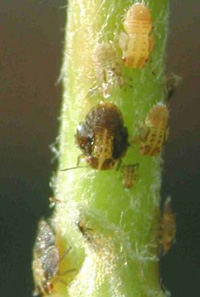 At Teynham Court Farm the introduction of Anthocoris nemoralis by releasing them from small plastic bottles placed in the orchard is the modus operandi.
At Teynham Court Farm the introduction of Anthocoris nemoralis by releasing them from small plastic bottles placed in the orchard is the modus operandi.
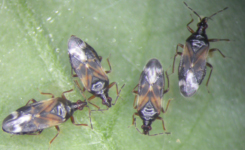
Antholine nemoralis
Anthocoris nemoralis is the more abundant and efficient controlling factor of Cacopsylla pyri, the 'Pear psylla,' in Europe. It is a polyphagous predator that can be found in many crops or wild plants other than pear orchards.
Bottles each containing 200 adults in dispersal material are released in the spring season. The bugs are very mobile and can fly very well so 5-6 release points per hectare are enough to have a good dispersion.

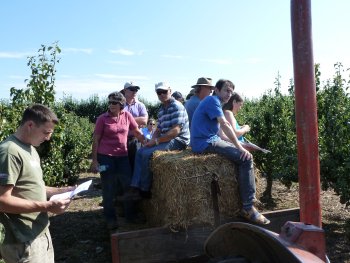


All of a twist!
Next on our tour of Teynham Court Farm, a young Bramley orchard. As they are young trees they had already been picked for the early market.
The main feature of interest was the 'corkscrew' method used on the central leader. Designed to slow the upward vigour and encourage fruiting wood close to the central leader, the trees looked very well balanced. In addition to the central leader corkscrew, the base branches had been 'cracked' in the May following planting, ensuring the ideal branch angle.


From the young Bramley we moved onto adjacent Cox Lavera and Early Windsor orchards. Again the Cox has been modified to take advantage of extra tonnage on the lateral training of the leaders. The Early Windsor are grown on a more traditional centre leader tree without a wire support system.
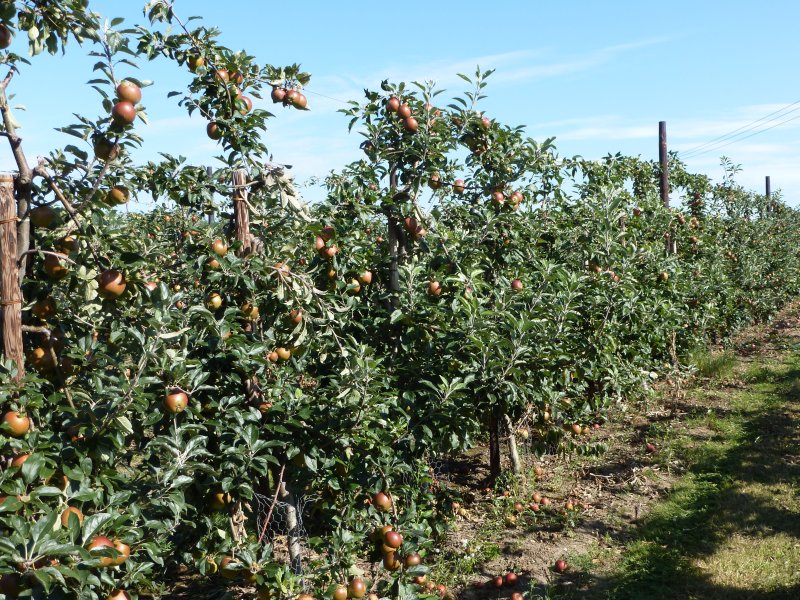

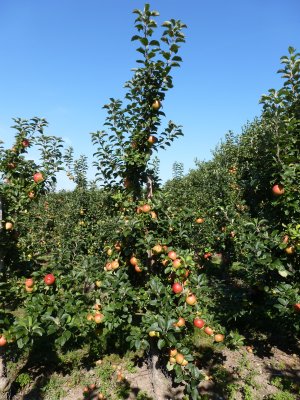
Next a young Gala Schniga orchard using a Golden Delicious interstem, planted in Autumn 2011, and now in its first leaf. Chris commented this is 'last years model' a comment that we would appreciate better later on our tour. Last years model it may turn out to be, but a large part of our apple industry have invested in this 'format' with trees spaced circa 0.9 metre apart and rows at 3.2 metres, with an intended height of 4 metres, and planned for mechanical pruning, mechanical thinning and the use of platforms for maintenance tasks (tying tops etc.) and picking upper levels of the tree.


Our next stop, the young ZARI orchard, where we had the opportunity to 'taste' and discuss the virtues of this very promising variety. Recently picked and on the way to a Supermarket, the ZARI tree is a relatively easy tree to manage. This orchard has 10% Gala trees as pollinators.

Chris told us managing ZARI is relatively easy as long as branches on the central leader (as shown below) are not allowed to become dominant; removal of the strong young branch using a 'dutch cut' (leaving a short stump) allowing new growth to develop and as seen below terminal fruit buds are forming on this young (2012) replacement wood.

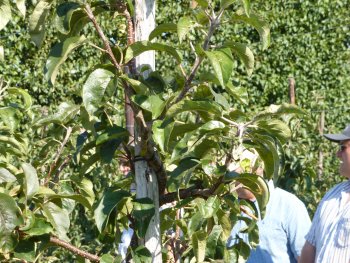
Our last orchard was the Twin Leader, or to give it its proper name; Bibaum!
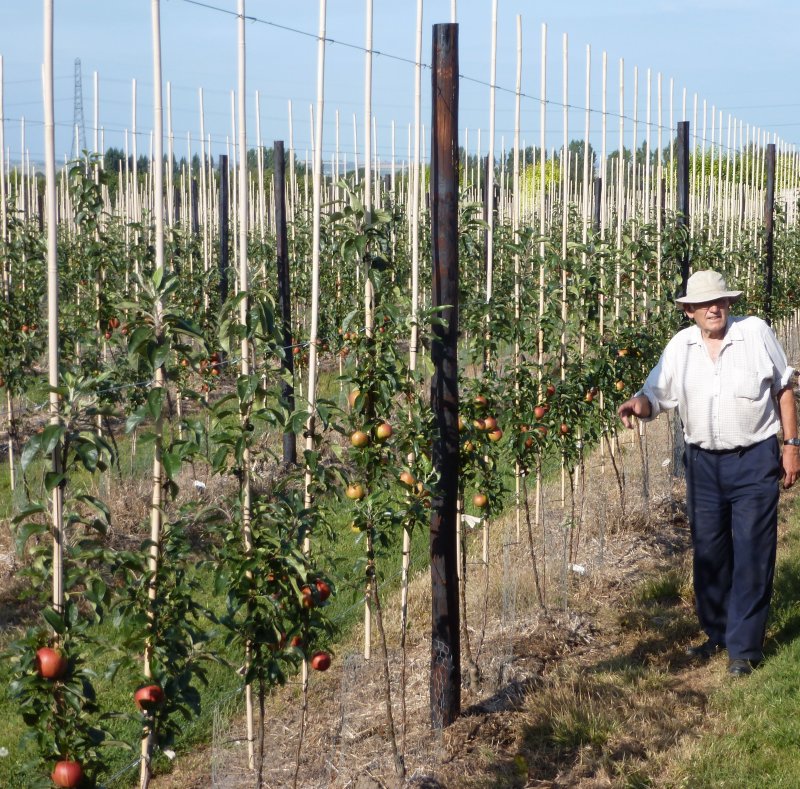
This new Gala orchard, planted in December is split into two Gala clones; Annaglo and Schniga. English Apple Man readers will remember my visit to The South Tyrol in late July. See Journal for 27th July 2012.
 This Bibaum orchard is, as Chris Levett told us; "this year's model" and it is clear many growers are already convinced and committed to planting Bibaum orchards.
This Bibaum orchard is, as Chris Levett told us; "this year's model" and it is clear many growers are already convinced and committed to planting Bibaum orchards.
Stewart Wood is certainly 'up there with the trail blazers' and due to the physiology of Bibaum which is by nature a 'calmer tree' with less vegetative growth, believes it is possible to plant the rows closer together than the current 3.25 metres. This would increase the tree numbers per hectare and potentially yields beyond those currently anticipated.
Chris Levett explained that with an increasing need for high 'quality' yields and a reduction in costs, using mechanical pruning, mechanical thinning and mechanical (supported) harvesting, the need for a tree format to match is essential.

He said; "These technical innovations can only be used successfully if the shape of each tree is adapted for modern machinery. This need, led to the 'groundbreaking' idea by Mazzoni; to create a fruit tree small in volume which is suited for mechanical operations. It is also a requirement to make a tree that produces a high quality of fruits with good exposure to the sun"
To this end, a tree with two homogeneous and equal main branches was created, using two buds per tree, instead of the conventional one bud. The resulting tree has two equal main branches (leaders) arriving directly from the nursery and all ready to crop from 1st leaf.
Sheena Levett who travels extensively in Europe on behalf of FAST searching for new ideas and is the first line of contact with the nursery in Italy, answered questions from the growers visiting the FAST day at Teynham Court Farm
Rabbits at Teynham Court Farm:
Rabbits are a problem (as always) and the novel use of one wire guard to protect both leaders is very logical. In The Tyrol they painted the trunks or used 2 plastic guards, neither as complete as the Teynham Court system.


Planted at 1 metre by 3 metres with a density of 3,333 trees per hectare the cost of the trees would be circa £17,000 per hectare. Stewart Wood is keen to plant his next Bibaum orchard at a spacing of 1 metre by 2.75 metres with a density of 3,636 trees per hectare and an approximate tree cost of £19,000.
Advantages of Bibaum trees?
A narrow fruit wall will deliver better quality fruit. A reduction in training and pruning costs will deliver better yields. Optimum light exposure will make for an easier harvest (more picked on 1st pick and better sugar levels). The Bibaum system is suitable for mechanical pruning and thinning.
New Storage Complex at Teynham Court Farm.
 Before refreshments, we were shown Stewart's new storage block. 'State of the art' long term controlled atmosphere (C/A) stores. With a capacity of 1,500 tonnes (5,300 bins) and a combination of store capacity of 300 - 850 bins per store; 'adds a flexibility' which is so important for maximising marketing potential.
Before refreshments, we were shown Stewart's new storage block. 'State of the art' long term controlled atmosphere (C/A) stores. With a capacity of 1,500 tonnes (5,300 bins) and a combination of store capacity of 300 - 850 bins per store; 'adds a flexibility' which is so important for maximising marketing potential.
This new storage block at Stewart's nearby Castlewood Farm is in addition to 2,060 tonnes at Teynham Court (4,300 bins)
The ICA/STS built storage complex has electric and gas C/A storage. Monitoring is carried out by computerised systems which sends data to the internet allowing the buyer of the fruit A.C.Goatham's personnel can monitor the temperature and gas recordings of the nitrogen generator to assist in reading Oxygen & CO2 levels in each store.

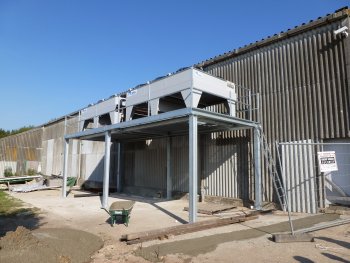
This new storage complex is a large undertaking and when we visited on Tuesday 4th September there was still some work to do. Frustrating for Stewart Wood has been the delay in the electricity supply which had been promised for some time, and now, 'fingers crossed' would be installed on Monday of 'this week' e.g. 10th September.
 With picking dates scheduled for mid September, it should be ok. Last year; an exceptionally early season would have been a disaster scenario!
With picking dates scheduled for mid September, it should be ok. Last year; an exceptionally early season would have been a disaster scenario!
English Apples are creeping onto Supermarket shelves!
Finally; I bought these Worcester Pearmain in The Coop in Cranbrook in Kent on Wednesday and they are so much better than the immature Worcesters bought in Morrisons 8 days ago!
And in Sainsburys today (Friday) a 4 pack of Galmac grown by a friend; Robert Rendall at Boxford Farm in the village of Stoke by Nayland in Suffolk. The EAM is advised modest supplies of Galmac may be found in M&S and Waitrose; "but don't blink" or you will miss them!
It is hoped Galmac will establish itself as an early variety; not as early as Discovery, but earlier than Worcester Pearmain or Early Windsor.
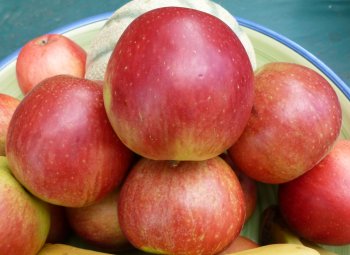

The 2012 harvest is under way!
As I write this Journal, growers are getting stuck into harvesting Apples & Pears for long term storage. Most Bramley & Conference for long term has been picked and a start made on Cox this week, although the bulk of Cox will not be underway until next week.
Quality Fruit Group (QFG) state that 'average' Cox orchards should have been picked this week! But colour is a key factor with Cox and growers sometimes 'chance their arm' a bit by waiting for enough red colour to make for a decent 'first' pick.
Gala should get underway in earnest for LTS by the following week. e.g. W/C 24th September. BUT, QFG advice indicates next week; W/C 17th September is the 'optimum' date for harvesting Gala for long term storage.
The general consensus is that most orchards are coming off lighter than estimated!
The EAM understands, it is possible the first trickle of Cox from very early sites will creep into Supermarkets by next weekend; 22nd September.
Next week The English Apple Man reports on a visit to The Co-operative Farms new venture at Highland Court Farm at Bridge, near Canterbury in Kent.
Take care
The English Apple Man